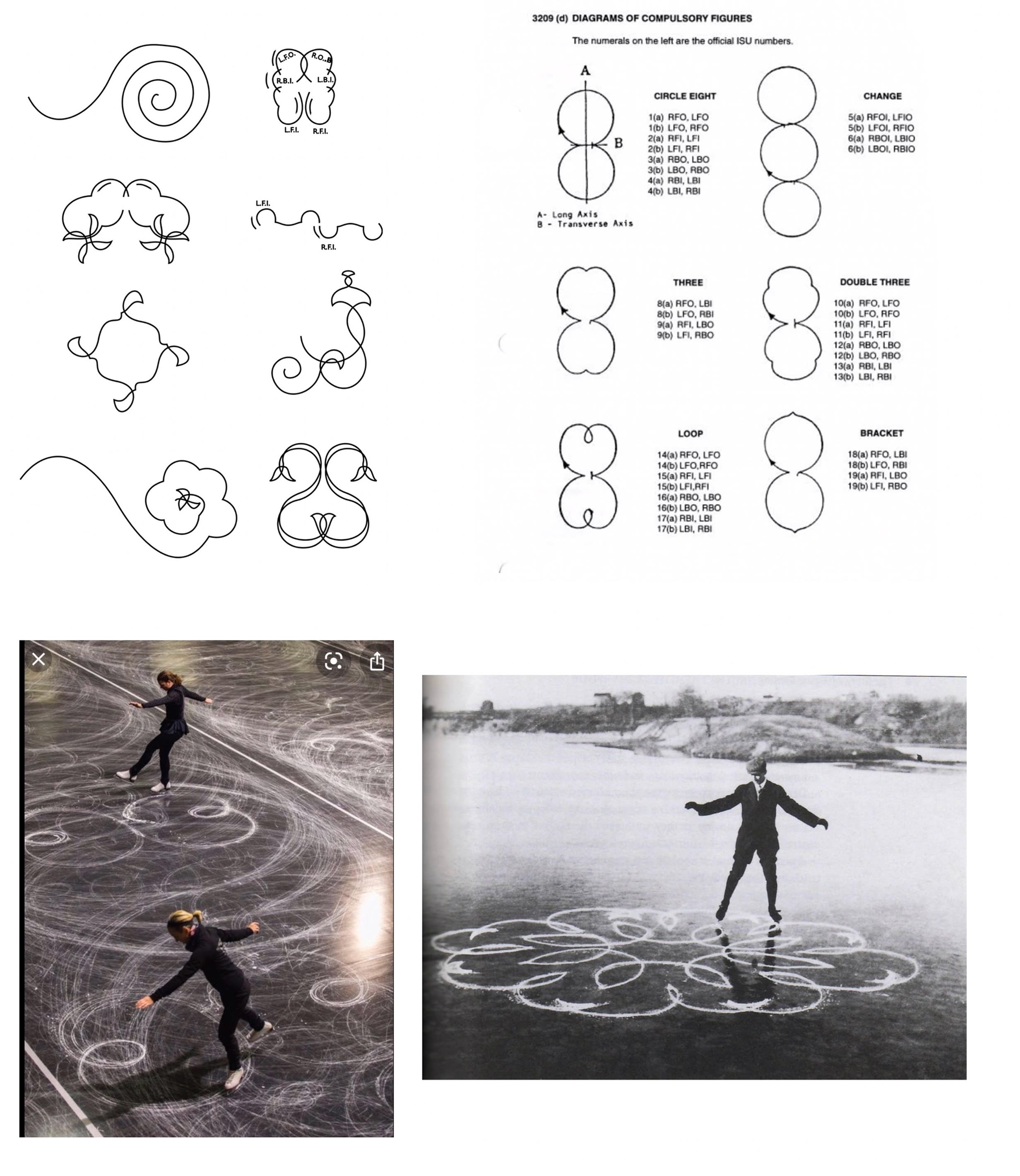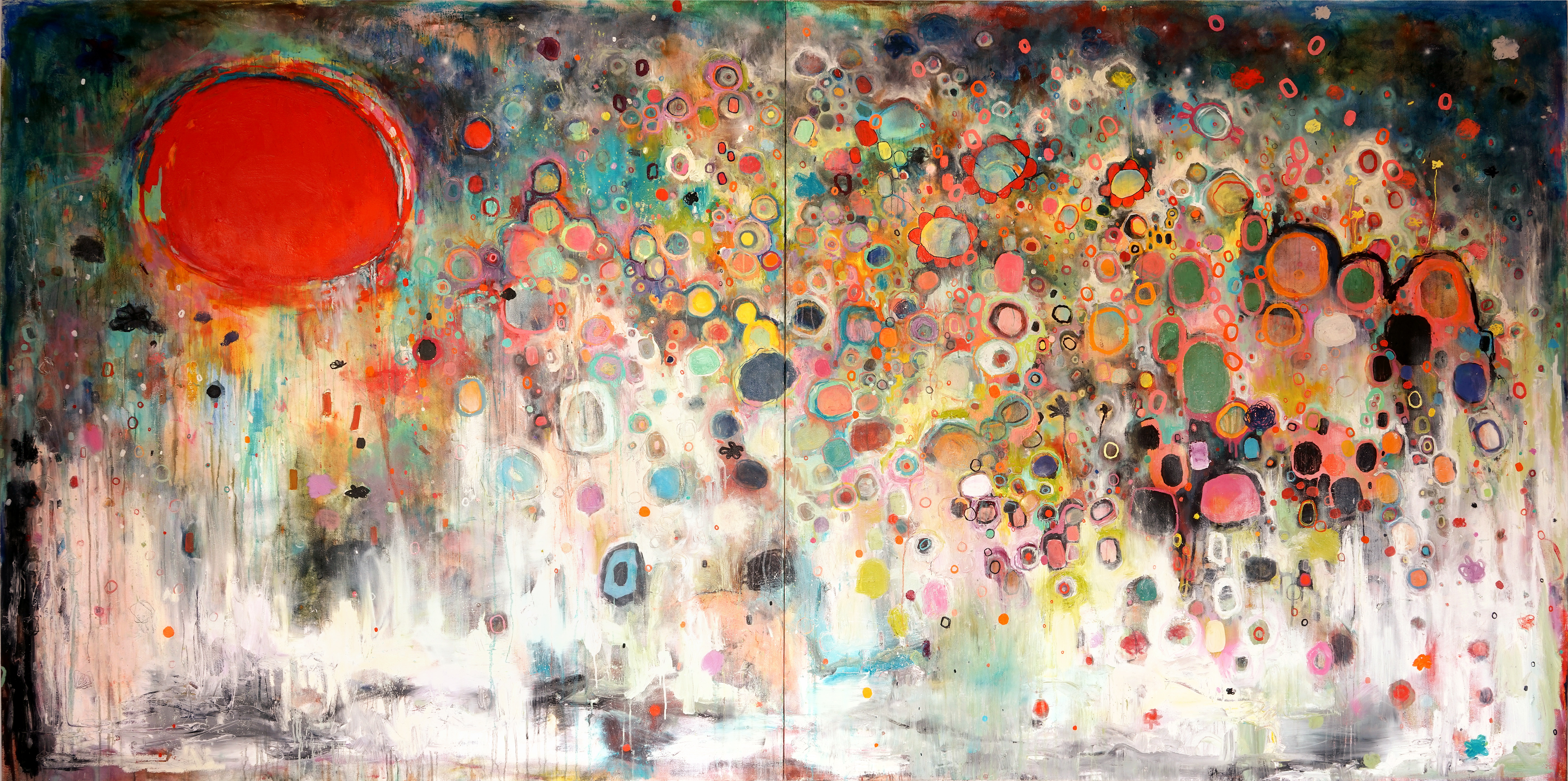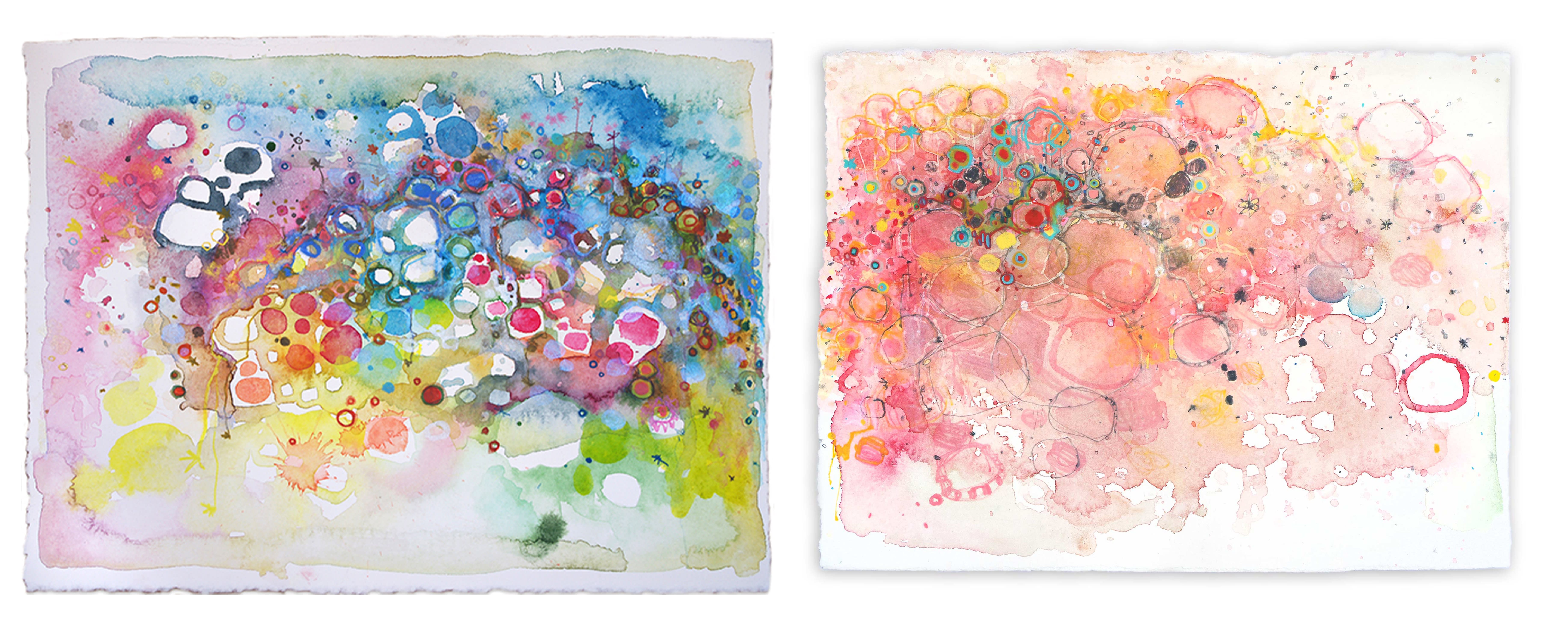
The process of curating Clara Fialho’s first exhibition in our Miami gallery wasn’t exactly complicated, but it, much like Fialho’s work, can be described as balanced and incredibly layered.
The fact that I’d only seen them on or through a screen before embarking on this project was the best way to start, now that I think back to it. I was able to understand her pieces through an academic lens considering her desire to communicate without telling a viewer how to feel or what to think; I knew that, conceptually, her approachable palette has Jungian, surrealist bones, and I conceived of them as points for reflection in our Miami gallery, which is narrow and naturally lit. Still, it wasn’t until I slowly unwrapped the pieces that Clara sent for the show in our Miami gallery—which has been lovingly described as a “closet”—that I experienced a good, old fashioned, visceral Oprah-branded “a-ha” moment.
At first glance, Fialho’s pieces evoke playfulness, like a materializing of playground joy, bubbliness, even. Her watercolors and oil paintings alike are bright and so beautifully stubborn, as far as traditional ideas about space, negative or otherwise, and color pairings are concerned. Brianna Luz Fernandez, another CAMP curator, describes Fialho’s work as airy: “there’s a lot of air, emotionally and physically in terms of space, in her work, giving [her pieces] an ethereal quality. And, yet, there is so much thought, experience, and feeling there—like, years go into them. It’s a juxtaposition of how a work looks and feels, aesthetically and in terms of her energy, with the duality in her, that creates this balance.” After a month, it’s obvious that Fialho’s ethereal aesthetic isn’t a mere exploration of the fleeting, high—happy—points of life, and they’re certainly not pain masking as easy, in theory. Fialho’s work is neither simply colorful and bright, nor are her pieces highly-codified and heavy; they’re both, and all, and more.
Dreamscapes, which was ultimately named for the artist’s use of space, relies on a fundamental acknowledgment that to be human is to be complex, even if it’s complex in a sophisticated way. Within us are boundaries we define for ourselves, layers of experience and growth on both individual and collective levels, dreams and ideas kept in our pockets, and above all else, the desire to to make sense of that which enamors or confounds us in the hope of making something beautiful out of the rough go-arounds that mark life. As Fialho puts it, “no matter how personal the work is, art can show us that no experience is unique to one individual, and that is what makes it so powerful."
Read through the entire interview to learn more about Fialho’s journey as an artist, her artistic and personal influences, and her understanding of the human experience como la cigarra.
Where does your relationship with art have its genesis?
I can’t point to a specific moment in my life where I decided to make art. I could read and write by the time I was 3. So instead of hiring a babysitter, my parents would just hand me a pile of comic books and walk away. My favorite was “Mônica.” It was about a little girl who would beat up her bullies with a stuffed rabbit. Eventually, I started making my own comics. They were full of dogs, witches, and mazes. I was socially awkward growing up, so I would draw all day to pass the time. I always knew that making art is what I wanted to do.
What drives your creativity?
I just have this innate need to create. Artists have to make sense of the world around them before putting something back into it. No matter how personal the work is, art can show us that no experience is unique to one individual, and that is what makes it so powerful.
Where do you find inspiration?
I find inspiration in everything around me. Things I see, read or hear; dreams; the human experience. As an adult figure skater, I am also fascinated by figure skating diagrams. Every element in figure skating is based on a “figure” that must be traced on the ice. I find inspiration in this beautiful mess that is life.

What are known in figure skating as "compulsory figures." Their neatness is largely dependent on a skater's skill.
How would you describe your relationship with painting, then? Is it simply based upon an emotional, spiritual, or visceral need, or would you say it’s based on the pulse points of your career up to this moment?
My relationship with painting in general is definitely defined by a visceral need to create. I would describe it as emotional, not so much spiritual, although early in my career I came across Unamuno’s “Tragic Sense of Life.” The following passage had a profound impact on me:
“All the cells of our body combine and co-operate in maintaining and kindling by their activity our consciousness, our soul; and if the consciousness or the souls of all these cells entered completely into our consciousness, into the composite whole, if I possessed consciousness of all that happens in my bodily organism, I should feel the universe happening within myself, and perhaps the painful sense of my limitedness would disappear.”
That was a turning point in my work. I was also very interested in Carl Jung’s theory of the collective unconscious at the time. Up until then, I had been making representational work, so there was this shift towards abstraction. I started to develop a language that was less personal, and that allowed me to communicate these ideas.
What does your process look like? Does it differ depending on whether you're working on, say, a massive painting or a watercolor piece?
I usually start small. I enjoy making small watercolors for practical reasons. I like to sit at my desk and work on these intricate details for long stretches of time—especially because my technique requires me to lay them flat. Oil painting is messy, and I enjoy the freedom of making them on a large-scale, although I usually plan them in my sketchbooks first. It’s just what works for me.
How do you connect to other media? Will you ever incorporate other media into your own work?
I have always approached art with curiosity. I am constantly experimenting with new materials—different oil mediums, oil sticks, inks, gouache, Papier-mâché, found objects, anything water-soluble—I spend a lot of time researching techniques, and making sure that all my pigments are lightfast. I always find myself returning to watercolors and oils, though.
Can you describe your studio space? What about it makes it yours?
My studio has one large wall that is surrounded by windows. In it you’ll find plants, books, and a growing collection of pebbles and shells that my friends and I mail to each other in elaborate packaging.
Who do you make art for, if anyone?
I hope that my work will be universally understood or felt. Over the years, I have developed enough confidence in it that I can simply focus on the process and what I am happy with. I don’t feel it is my job to guess how others will react.

Como la cigarra, 2019. Diptych; oil on canvas. 72 x 144 in. Clara Fialho ©
From a curatorial perspective—mine at least—your work holds a liminal quality, which is to say that it isn’t one thing or the other, it just exists on its own, like a fluid point for the audience to take what they need and even, vice versa, for the audience to leave what they need to. In other words, it’s totally transformative. Do you experience this as you work?
In my compositions, every element is unique and important, but they are also important as part of a whole. Sometimes, if I can make a piece quickly enough without struggling, there is still an element of surprise to it. Maybe that is the closest I will ever get to experiencing what the viewer does, other than viewing very old work that I have forgotten. When that does happen, I am able to react to it emotionally. Other than that, I think it’s impossible for me to separate myself from the work enough that I am not looking at it from a technical perspective.
Especially within the bigger works, like Como la cigarra, which touches upon very specific ideas and energy to do with collective action, tension, and war, there’s an undercurrent of human strife and hope mixed into one, almost as if you’re reflecting the real complexities of being alive and, let’s say, feeling a certain way about the world. Is this purposeful or does it come naturally?
I would say it is a feeling that comes naturally, but for this piece it was very deliberate.
There is a garden behind my apartment building, and one summer, there was this brood of cicadas emerging. I was feeling down, and one of the cicadas flew through my window. It reminded me of a song called “Como la cigarra” (like the cicada), written by Maria Elena Walsh, and made popular by Mercedes Sosa. The song became a response to the military dictatorship in Argentina in the 70’s and 80’s, and was banned for several years.
This was a time of U.S. intervention throughout Latin America. I was born in Brazil, a year before the end of the dictatorship there. Coming from a musical family, I grew up listening to music that was very political. Many of these songs were “disguised” as love songs in order to evade government censorship. I was too young to understand the meaning behind these songs, but they were so eerie that I couldn’t listen to them at night or I would start crying—and I was terrified of Chico Buarque!
Anyway, “Como la cigarra” was one of them. It is a song of resilience, be it personal or political. Cicadas survive by emerging from the soil in numbers. They do this every few years depending on the species, so that predators can’t possibly eat them all, and they are loud!
Walsh says, I'm grateful to adversity and the knife wielding hand for it did a bad job at killing me and I carried on singing. Singing to the sun, like the cicada does.
I tried to interpret the feeling behind this song by making the largest painting I could get through the door. The piece took me about 4 years to finish. It depicts the cicadas as these colorful organisms reemerging from the earth, and “singing to the sun.”
The world is slowly starting to emerge from a pandemic, and we still have to deal with the issues of climate and racial justice. On top of that, technology allows us to witness in real time the horrors of Russia’s invasion of Ukraine. How do we deal with collective trauma? Art has the ability to empower people, and bring them hope at times when it’s so easy to give into resignation. That being said, it seems like the perfect time to be showing that piece.

(Left) Untitled #274, 2015. Watercolor on paper. Recently acquired by the Agnes Gund Collection. (Right) Untitled #318, 2016. Watercolor and pencil on paper.
Your paintings in particular are multi-layered abstract exploration of very tangible concepts and ideas, such as universal collectivism, psychology, and a surrealist perspective.
I have always been interested in 20th century art, particularly artists such as Paul Klee, and Joan Miró. Their work was a response to the world around them. It was a denial, and a desire to escape a reality that was absurd. For Klee it was World War I, and Miró, the Spanish Civil War. I believe that any type of conflict comes from our desire to separate ourselves from one another.
There’s a recurring use of orbs or circular figures in your work, which I think lend themselves to this abstract humanism, if you will. The circle itself is a totem of infinity, wholeness, perfection, and are undoubtedly universal, unlike most things.
Early on in my career, I became interested in the ideas of the collective unconscious and how we function as individuals within larger organisms. These round shapes are universal symbols. They could be tiny cells, or giant stars. Perhaps there’s a feeling of comfort in knowing that as part of something greater, none of us are all that important and neither are our problems.
Your work is also, literally, multi-layered. It’s not as evident from afar, because of brilliant cohesion, but from up close, there’s an immediate access to all of these layers of paint, naturally occurring or imposed/created textures, negative space alongside the total opposite, all living on one piece. Can you elaborate on this process and why you do it?
In my oil paintings, I like to replicate the washes that I can achieve with watercolors. For that I use a combination of oils of different densities, as well as solvents. I usually start by laying them flat, just like the watercolors. I let each layer dry, and build them up in order to create depth.
To me, it has become a language that I’ve developed and feel comfortable using. I like it when people come up to me and tell me that that my work has brought them joy, or that it’s given them goosebumps. It means I must be doing something right, but then again, it is beyond my control. I can only hope that they will take something away from it.

Fialho in her studio (left) working on The Tenderness of Genuine Sadness (right). Oil on canvas. 32 x 47 in.
Clara Fialho ©
How has your practice influenced you? Do you find it changing as you do?
I think that my practice has influenced me in the sense that it is an integral part of my identity. Being an artist defines the way I see and respond to the world. I would like to think that my work has matured as I have.
Do you have any dream projects?
I would like to make some really big paintings, and maybe collaborate with artists from other disciplines, like dance or theater.